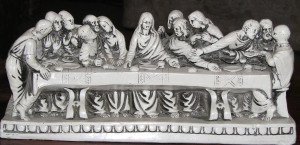Sir Colin Humphreys is Professor of Materials Science at Cambridge University, and his most unusual paper – one in the prestigious scientific journal Nature – is on the dating of the crucifixion of Jesus. How did this come about? Humphreys is a Christian, so as he said in the book Real Science, Real Faith, he has ‘made it a particular personal interest…to try to pin down more accurately the dates of some important biblical events.’
I have written before on Humphreys’ work on the dating of the birth of Jesus, but as Easter is coming soon, it seemed a good time to talk about his death. Jesus’ crucifixion is dated around 30-33AD, but Humphreys and his astrophysicist colleague W.G. Waddington came up with the more exact date.
The date given in the Nature article was arrived at in four stages:
- Pontius Pilate was in procurator of Judaea when Jesus died. The Roman historian Tacitus recorded that Pilate was in this post from AD26-36, so we have a span of ten years to look at.
- All four gospels report that Jesus died a few hours before nightfall on the Friday before the Jewish feast of Passover, and the book of Acts states that there was a lunar eclipse (the moon turned red) on this day.
- Passover was always held on the 14th day of the month called Nisan. Reconstruction of the Jewish lunar calendar in the first century AD shows which day Passover fell on for each year.
- All that remains is to show in which year there was a lunar eclipse – visible from Jerusalem – on the Friday before Passover.
The only date that met all four of these criteria was Friday 3rd April AD 33, around the time of Jesus’ 37th birthday.* Bearing in mind that Humphreys and Waddington wrote this paper in their spare time in 1983, before obscure astronomical records might have been accessible online, the depth of their research is impressive.
The only mystery left to clear up was the difference between the accounts in Matthew, Mark and Luke, which mention the ‘last supper’ as a Passover meal, and the version in John which says it happens on the day before Passover. This is dealt with briefly in the Nature paper, and more fully in Humphreys book The Mystery of the Last Supper, published by CUP in 2011.
It turns out that there was more than one lunar calendar in use at the time of Jesus’ death. One stuck to the original dating system that Moses used, and a newer version (still used by Jews to this day) was developed during the Jewish exile in Babylon. This confusion was probably tolerated by the temple authorities for practical reasons. If Passover fell on two different days, that gave more time to running celebrations for vast numbers of people in the temple.
Humphreys said in a recent interview, ‘Jesus was identifying himself explicitly with Moses. He was setting himself up as a deliberate parallel. He then died on Nisan 14th, just as the Passover lambs were being slain according to the official Jewish calendar as well. These are deep, powerful symbolisms – and they can be based on objective, historical evidence.’ It’s refreshing to find such a thoroughgoing example of science and faith working together.
*By Humphreys and Waddington’s dating of Jesus’ birth. So the traditional age of Christ at his death of 33 may be wrong. This extended age doesn’t cause any contradiction with what’s in the Bible.




